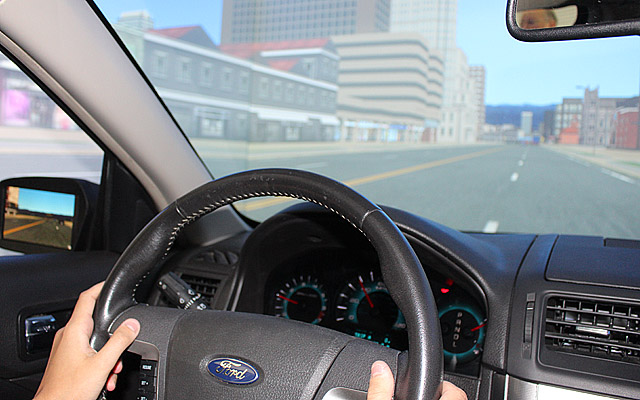Daily Business Report-Jan. 2, 2018
In simulator, driving experience encompasses not just what can be seen in front of them, but also in mirrors.
Driving Simulator at UC San Diego
Evaluates How Eye Diseases Affect Driving
By Scott LaFee | UC San Diego
The University of California, San Diego School of Medicine is the first ophthalmology department in the nation to feature a fully dedicated high-fidelity, highly realistic driving simulator for evaluating the effects of visual impairment on a person’s driving performance.
Located in the UC San Diego Shiley Eye Center’s new Visual Performance Laboratory, the simulator occupies an entire room. Drivers sit in an actual Ford Fusion cabin mounted on a motion platform and look out onto a realistic cityscape with road and traffic projected on large-screen panels covering a 180-degree field of view. The scenes interactively respond to the driver’s changes in direction and speed.
The car pitches, rolls and rumbles in response to acceleration, braking and road conditions. The three adjustable rear-view mirrors display images of what would be visible behind the vehicle.
Felipe A. Medeiros, MD, PhD, professor of ophthalmology and the Ben and Wanda Hildyard Chair for Diseases of the Eye, and colleagues plan to use the simulator to investigate how eye diseases, such as glaucoma and age-related macular degeneration, alter a person’s visual performance and ability to drive well and safely.
Glaucoma is the leading cause of irreversible blindness and visual impairment in the world, and it is believed that people with glaucoma are more likely to be involved in motor vehicle accidents.
“We know that standard visual acuity or visual field tests may not provide enough information to evaluate whether a person is capable of driving safely,” Medeiros said. “The driving simulator will allow us to assess visual performance in a realistic and demanding scenario, providing a much better evaluation of the impact of eye diseases on driving fitness.”
Among the notable advantages of the simulator is that driving skills can be tested under conditions that would be too dangerous to test in reality. With the simulator, for example, it is possible to keep track of a driver’s ability to maintain lane position, follow behind another car on a windy road, negotiate a curve and detect and avoid hazards, such as pedestrians crossing a street. The simulator can also recreate night driving and driving in heavy fog.
In addition, the simulator can be used to measure changes over time, to better understand the progression of different eye conditions and their impact on visual performance and driving.
“One of the purposes of the simulator is to try to better evaluate and determine who is at higher risk for becoming impaired in their ability to perform everyday tasks,” said Medeiros. “Those at higher risk may need to be treated more aggressively, whereas those at lower risk may be treated more conservatively.”
The first patients to use the simulator will be participants in an on-going, long-term National Institutes of Health study on eye diseases, headed by Medeiros with co-investigators Peter Rosen, MD, associate clinical professor; Robert Weinreb, MD, chairman and Distinguished Professor of Ophthalmology and the Morris Gleich, MD, Chair of Glaucoma, and Linda Zangwill, PhD, professor of ophthalmology-in-residence.
These patients have already had their visual and driving performances evaluated on a smaller, lower fidelity version of the stimulator. Researchers have used this data to identify components of computer driving scores that are most predictive of a person’s history of collisions, as recorded by the California Department of Motor Vehicles.
“The research will now be expanded with the use of the new simulator, allowing us to test a much larger number of hypotheses in more realistic scenarios,” Medeiros said. “There are people who are driving who should not be and there are people who aren’t driving but could safely. The research on the new driving simulator will help us identify those at higher risk for being involved in crashes and provide better guidance to patients and interested parties”.
The scientists hope to also use the simulator to train drivers in how to compensate for skills diminished by age or disease. “There is evidence suggesting that about 50 percent of motor vehicle collisions are caused by deficits in the ability to process visual information and allocate attention while driving,” Medeiros said. “We may be able to train people to get better on how to perform these tasks.”
_________________
Friends of SDSU Collect 100,000
Signatures on Stadium Initiative
Friends of SDSU announced it has collected more than 100,000 signatures from San Diego voters thus far for its SDSU West Initiative, which proposes the sale of the Mission Valley stadium site to San Diego State University at fair market value.
“Supporters have successfully gathered many more than the required 71,646 signatures. Once verified, these signatures will qualify SDSU West for a 2018 ballot,” said Kim Kilkenny, Friends of SDSU Steering Committee Member.
If the signatures are certified, the city clerk will certify the measure for the ballot and present it to the San Diego City Council, which can either approve the initiative outright or send it to the ballot for a vote.
If approved, SDSU would be required to develop a comprehensive plan for the site. SDSU’s vision includes more than half of the site as public open space, including a permanent River Park, campus tech and office space, community-serving retail, a variety of housing opportunities, hotel and conference center, public transit connectivity, and a multi-use stadium.
_________________
SCORE Upcoming Workshops
Business Plan B: Setting Goals & Telling the World
January 6, 2018 – 9 a.m. to noon.
FEE: $20
Are You Ready to Start Your Own Business
January 6, 2018 – 1 to 4 p.m.
FEE: $10
Internet Marketing in the Real World
January 9, 2018 – 1 to 4 p.m.
FEE: $20
The Art of Negotiation
January 10, 2018 – 9 a.m. to noon
FEE: $20
QuickBooks Desktop Part 1
(Not for Online or Mac)
January 11, 2018 – 9 a.m. to noon.
FEE: $20
Business Plan C: Will You Make Money?
January 13, 2018 – 9 a.m. to noon.
FEE: $20
Business Basics
January 13, 2018 – 1 to 4 p.m.
FEE: $20
_________________
Judge Peter C. Deddeh Starts 2-Year
Term Presiding at San Diego Superior Court
Judge Peter C. Deddeh began a two-year term as presiding judge of the San Diego Superior Court on Monday. Deddeh, a 20-year veteran of the Superior Court, was elected to the top judicial leadership position by his fellow jurists in November. He succeeds current Presiding Judge Jeffrey Barton, who finishes his term on Dec. 31. Read more...
_________________
San Diego has busy Start to First
Day of Recreational Marijuana Sales
The curious and the committed showed up early Monday morning for the first day of recreational marijuana sales in California, keeping stores busy across San Diego, from Otay Mesa to Bay Park.
“This is historic. I wanted to be the first person in line,” said Richard Gold of Lemon Grove, who drove through the pre-dawn fog to reach A Green Alternative, a retailer in Otay Mesa.


